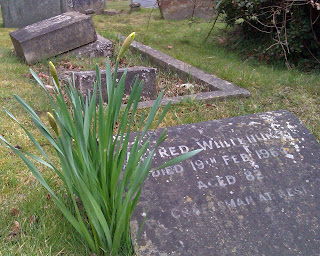There's one!
 |
| Not the best view you will ever see of a train on the Bluebell Railway's Hill Place Viaduct |
On 1st August 1882, Francis Whitehurst, soon to become the tenant of Hill Place Farm in East Grinstead, saw the first service train crossing the viaduct to which the farm gave its name. This was not the scene from the 1830s, with people and livestock scattering from the spark spitting, smoke belching monster. Locomotive design had advanced to make a more civilised beast: the
Bluebell Railway, who now own the viaduct, still operate two locomotives, No 55
Stepney, and No 72
Fenchurch from that time.
 |
| Works plate from Fenchurch, the oldest railway locomotive continuously in service in Britain |
The first railway reached East Grinstead in 1853, cutting through the neighbouring Copyhold Farm, a slightly misleading name, as all farms in Imberhorne Manor were
copyhold until they were enfranchised in the 1850s. The name was preserved in 1921, when East Grinstead Council built Copyhold Road, its first social housing, on the other side of the viaduct from the picture above.
Francis left Hill Place in around 1896, when the
Blount family of Imberhorne Manor purchased the freehold to farm it with their own staff, increasing revenue without increasing costs, and avoiding the fate of many estates in the agricultural depression of the late Victorian years. He went to farm as a tenant of the Ford Manor estate in Dormansland, until he retired to the village a couple of years before his death in 1926.
 |
| My great-great grandfather's last farm |
Not that our family's association with Imberhorne was over. A couple of deaths in quick succession in the 1950s meant the Blount family had to sell a substantial part of the estate to pay death duties. Most went to housing, but some was used to build Imberhorne School. In 1974, Francis' great granddaughter, my mother, needed a job fitting my school holidays, and where better to find one than in a school? She worked at Imberhorne for 25 years until her death in 1999.
With this connection, I was keen to catch a shot when the
Bluebell Railway started their service to East Grinstead on March 23rd. My plan was scuttled by unseasonable weather between my home and East Grinstead.
So, I travelled a couple of weeks later, following the Medway from Maidstone, where I had watched the
Isthmian League Cup Final, to its source, taking the picturesque Medway Valley Line to Tonbridge, then, in a reverse of the
East Grinstead Song, the
291 bus from
Tunbridge Wells.
When Channel 4 made a documentary in 1985 called
God Rot Tunbridge Wells, about the composer
Handel, the title based on his reported comment after a bad reception at a concert in the town, my mother remarked what a sensible man Handel must have been - she could not stand the place. I found it quite pleasant, but when I had checked the time on the Millennium Clock ...
... looked round the museum and the
Church of King Charles the Martyr (attended by Princess Victoria before she became Queen), and perambulated through the
Pantiles (originally surfaced with tiles shaped in pans) ...
... I felt I had exhausted all it had to offer the casual visitor.
The Bluebell were still running their opening gala service, with a train up and down the line about every hour and a quarter, so I did not have long to wait.
The view from the train includes some of my great-great-grandfather's fields, although not the farmhouse, hidden from view by more recent buildings.
Turning back to our first picture, I would have found a better place to stand to get the train in if I had paid attention to a picture from earlier in the day. For some reason I thought in front of the tree peeping up from below the parapet might be a good vantage point.
 |
| Garden Wood Road from the Viaduct |
Our journey has also been following Francis' middle son Alfred, my great-great uncle. He was born in view of the viaduct when it was being built, spent most of his life in Groombridge, through which I came on the 291, and died in hospital a few hundred yards from this picture. Our last task of the day is to pay our respects, in Dormansland, where he shares a grave with my mother and grandmother.
We can see how cold the spring has been, we are well into April, but the daffodils (remnants of those planted in 1964 - I keep thinking about planting more, but usually at the wrong time of year) have still to bloom.
There are some more pictures from the trip
here.



















